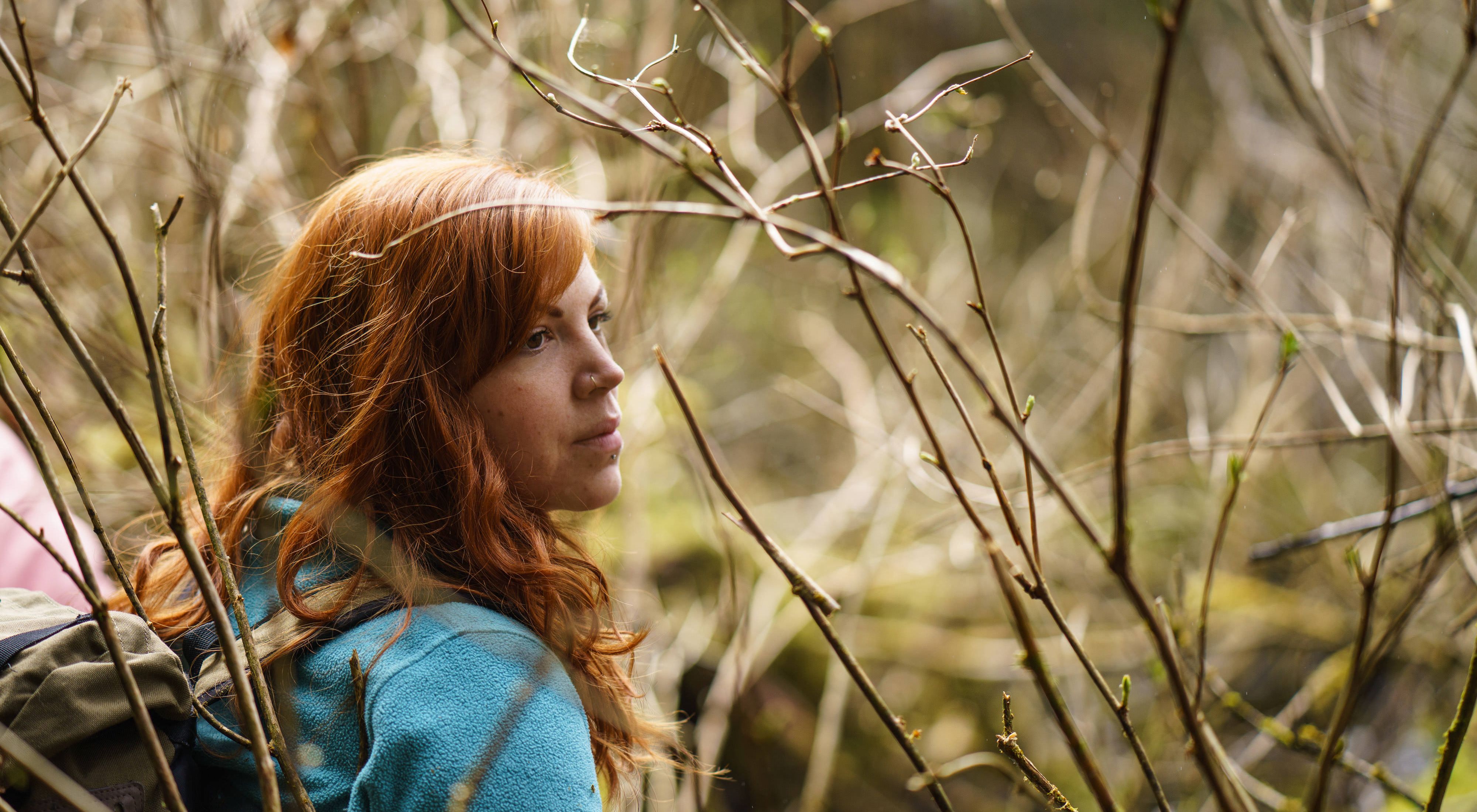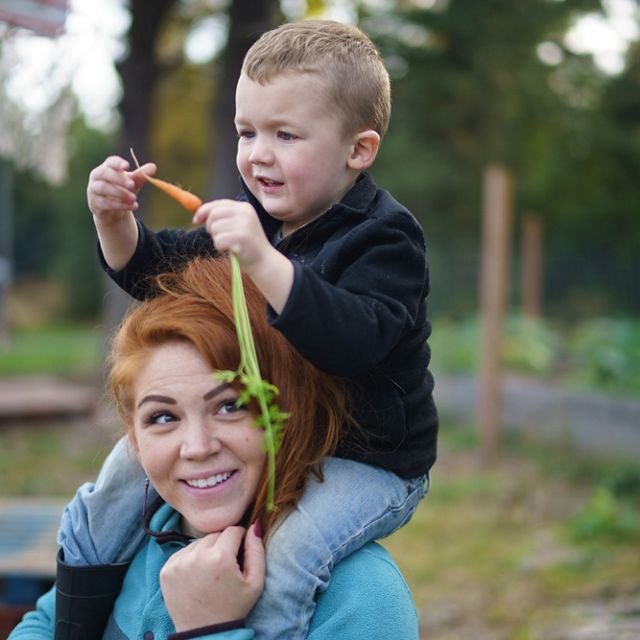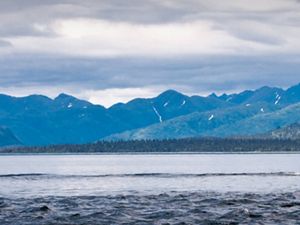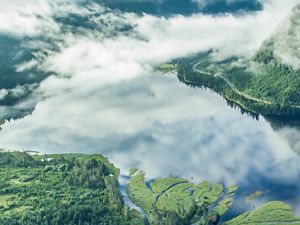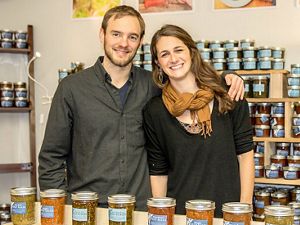Sustainable Southeast Partnership
A regional collective is building trust, renewing culture and protecting nature in Alaska’s Tongass.
Every day, Marina Anderson asks herself a question: “What would our ancestors have done?”
And for her, no two days are the same because it’s an out-of-office life. She’s good with a sharp knife. Adept at manipulating columns on a spreadsheet. Always ready to respond. Willing to walk the steps of Capitol Hill to lead on policy matters. Runs an effective meeting. Has an open door. Operates a 32-quart pressure cooker.
Home is on the coast of Southeast Alaska, as it was for her Haida and Tlingit ancestors: Think lush forest of towering trees, wisps of mist and fog woven through. She picks berries in the forest, as they did. She nets wild salmon and butchers deer for the table. As she learned from her father, she shares it all. It’s a way of life.
Anderson also directs the Sustainable Southeast Partnership (SSP), a regional collective impact initiative supported by the Indigenous-led Seacoast Trust in the mostly rural panhandle of Southeast Alaska. The SSP focuses on four core issues:
- forestry and fisheries
- energy independence
- food security
- localized economy
Collective impact is a model for addressing complex problems through collaboration between multiple organizations based on shared goals and a strong foundation of trust.


Sustainable Southeast Partnership in Action
The SSP concept arose out of the struggles of four decades of natural resource conflicts in Southeast Alaska, in which the timber industry and conservationists were the two main adversaries. Alaska Native communities were largely left out of the decision-making process, even as some of the logging was conducted on lands belonging to Alaska Native corporations.
Both the timber companies and conservationists presented the issue to the public in all-or-nothing terms. Meanwhile, many local people—including Indigenous people, business owners, commercial fishers, mayors and others—sought a more reasonable and nuanced way to chart a future for the resource-rich region.
In keeping with this more cooperative approach, conservation groups and Indigenous organizations came together to form the SSP. The SSP provides a salary match to support community catalysts in its seven member Tribes, and each catalyst works toward locally agreed upon community goals. These goals can include renewing the tradition of harvesting local food, restoring forests and streams and sustainable economic development.
“Harvesting is very significant in our Alaska Native communities. Especially our traditional harvesting because it’s part of our relationship with our ancestors and our environment around us,” she says. “It’s in our DNA to do the things that we do.”
The SSP has helped to bring people together to learn and reconnect with the shared traditions of harvesting wild foods in a healthy environment. People are netting wild salmon and preserving the catch by canning; making medicinals with wild plants such as devil’s club and other forest botanicals; picking brilliant thimbleberries, to make jams and fruit leather; collecting and preserving seaweed such as kelp; and harvesting and butchering deer.
Some community programs focus on restoring streams for salmon, or educating youth, or innovating new clean energy systems. But all such efforts have the community at the center.
Quote: Alana Peterson

We are modeling how people can prosper in this place, be stewards of our natural environment and be self-determining as individual communities and as a region.
Solutions from Within Communities
Now more than 15 years old, the Sustainable Southeast Partnership has successfully nurtured a new kind of collaboration to support conservation within its network. Today it includes seven Tribes and 10 other entities such as businesses and non-profits, including TNC.
“Collaborating as communities gets us even farther,” Anderson says. “And being able to talk with other communities that are in a similar economical state that we are, I think, is extremely helpful because a lot of times in the middle of rural Alaska, we feel like ‘Oh, that would be a great idea if I wasn’t in this remote village.’ But a lot of these ideas that are being planted around Southeast Alaska through the Sustainable Southeast Partnership are ideas that will work in the village.”
For the Indigenous leaders, the SSP was born from the imperative of cultural renewal. As Anderson says, “It’s about keeping the balance, remembering who we are…going out in the world to gather tools and experiences, and to come back and lift up my community with these new tools.”
Quote: Michael Chilton
Our identity is everything that was before us and everything that is now and everything that will be in the future.
The Ecology and History of the Tongass Forest
Anderson grew up on Alaska’s Prince of Wales Island, a rugged and remote tract of mountains and meandering coastlines the size of Delaware in the Tongass. It has a feel different from most anywhere else on Earth. It’s a place where trees—cedar, spruce and hemlock draped heavy with moss—grow all around. They’re up on steep mountain slopes, down along cascading salmon streams and right up to the bouldered edge of the roiling sea.
This is the Emerald Edge, a coastal rainforest that ranges from Washington, British Columbia and Alaska. As much as 200 inches of yearly precipitation makes it incredibly lush. These forests, with their big trees and living soils, do double duty as a major carbon storehouse for the planet. There are bears here, and wolves, and whales, seals and sea otters in the ocean’s bays and inlets. Tucked between forest and sea are Indigenous villages, like Kasaan.
Two centuries of colonization left scars in the many communities where the 70,000 people of Southeast Alaska live. It’s visible in the forest and in the waters of a place that abounds with plenty and should have enough resources to sustain communities and livelihoods. After all, Southeast Alaska salmon streams produce a quarter of the entire U.S. West Coast wild salmon harvest.


In this Tlingit, Haida and Tsimshian territory, decades of industrial-scale logging without opportunity for local or tribal consultation, and a period of overfishing, have taken a toll. In the early 2000s, North America’s timber industry battled for rights to log the old-growth forests here and left behind a changed forest. The fight left no clear winners, but it did succeed at fueling a generation of discord.
Anderson went far away to college, though if anything it may have only lent more immediacy to Prince of Wales Island’s ancestral tug. When she returned, for good this time, she signed on to help lead her tribe. Some will know Kasaan, pop. 60, for its art and history—the historic Náay Í’waans longhouse of carved cedar dates back to the 1880s. It’s a living work of architecture that, now restored, stands tall and proud with its giant beams and totem poles. Commonly known as Chief Son-I-Hat's Whale House and Totems Historic District, it was named to the National Register of Historic Places in 2002.
Making a New Way Forward
“I want to be that ancestor that our future ancestors are proud of,” says Anderson. “I want them to think back about their ancestors...and be proud of what we were doing.”
The SSP is at the leading edge of making that future for Southeast Alaska by starting close to home in small ways that add up to make an impact. A sustainable timber harvest that draws from today’s young-growth forests while sparing old-growth trees can support smaller sawmills and provide jobs. A more diverse regional economy can draw from the triple-bottom line of ecology, social equity and economic well-being—rather than the conventional single bottom line of financial profit.
The Nature Conservancy believes local priorities must guide conservation in places where people and nature need a strong future together. This begins with relationships and building trust. This is how the Sustainable Southeast Partnership works, and it represents the best way forward for people and nature.
In the Olympic coast of Washington, through coastal British Columbia, and through the remote panhandle of Southeast Alaska—the vast region where TNC’s Emerald Edge program is at work—this is what collaboration in the name of people and nature can look like. Trust comes first. Building and renewing communities able to withstand incoming forces of change comes next.
